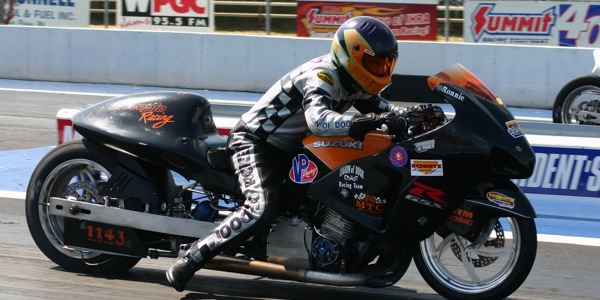Being a race promoter can call for making some tough decisions that don’t always sit well with racers. Longtime MIROCK and IDBL promoter Jason Miller, now of Miller Brothers Productions found this out many times.
Some decisions Miller had to make were second-guessed. Some were proven to be the right choice over time. Here is a flashback to one controversial decision from 2009.
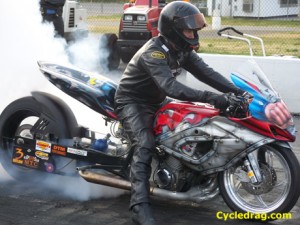
Outlaw Pro Street, featuring signature 75-inch wheelbases, 7-inch slicks and no wheelie bars, had long been the MIROCK series’ marquee category – even before the regional motorcycle drag racing promotion contested at Maryland International Raceway and Rockingham Dragway officially became known as MIROCK in 2003.
The unpredictable nature and rapid speeds of the nitrous-oxide-fed, long swingarm, Outlaws, made the class a popular attraction for fans. But as time went on participation in the class slowly began to wane and following the 2008 season MIROCK announced a major change. Outlaw Pro Street would be replaced by Pro Street, a category featuring the world’s quickest street legal motorcycles.
“We are known as a street bike series and I feel it’s a better overall fit,” MIROCK’s Miller said. “It’s unfortunate the Outlaw class didn’t work. We gave it the best run we could. We tried it with different sets of rules. We paid them well, we gave them a great purse all season. The money just wasn’t an incentive to get new bikes out there. This was our only option moving forward.”
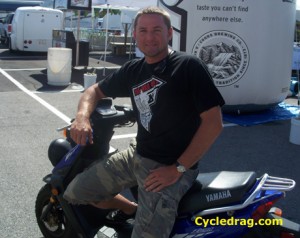
Some believe that the rule changes in Outlaw are what ultimately led to the category’s demise. The most notable rule change occurred after the 2006 season when turbo-charged motorcycles were banished from the class.
“The reason Pro Street has started to grow again is because they left the rules alone,” nine-year Outlaw Pro Street veteran racer Rob “Superman” Hunnicutt said. “It seems like over the last few years they have always wanted to change something. It’s hard for people to continue with their builds when the rules always change. I know of three bikes that were going to be built for 2009. Outlaw Pro Street was at its height when the rules weren’t changing. It’s like they can’t leave something alone and let it grow.”
Many believe the turbo ban crippled the class and when the combinations went down to nitrous only, the class became too limited and turned too many races away. Hunnicutt thinks by banning the turbos MIROCK may have taken the easy way out instead of finding a way for the nitrous and turbo bikes to compete on an even playing field.
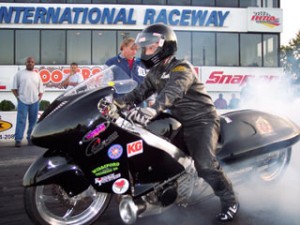
“I was all for them trying to find a way to keep the turbo bikes in the class. The nitrous bikes just needed changes to be competitive,” Hunnicutt said. “MIROCK decided it would be easier to just cut the turbos out all together and wash their hands of any headaches. It would have been nice if they could have went to an outside source to help even out the rules. The people and companies that make money off the class shouldn’t be the ones writing the rules.”
The woeful economy and rising fuel prices are also reasons for the recent lack in participation. In 2002 it wasn’t uncommon for MIROCK to have between 14-18 Outlaws at one event. In 2008 that range fell closer to between 6-10.
“It became more of a club than a class and a lot of the individuals in the club thought they only needed a certain number of racers to survive,” Miller said. “Outlaw started out as a Florida-based class, and when a lot of those guys quit running the participation went way down.”
2008 Outlaw Pro Street champion Ronnie Procopio says the economy is to blame for keeping many of the Outlaw racers at home, and believes the Pro Street class will battle with the same issue.
“There were a lot of people that didn’t want to travel or just didn’t have the money to finish their bikes,” Procopio said. “I think MIROCK is most definitely in for a rude awakening if they think Pro Street won’t have the same trouble in this economy. At least in Outlaw you could count on 6-7 bikes coming consistently”
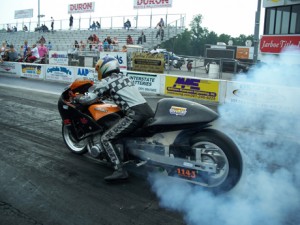
Another reason Miller believes the Pro Street class will be more successful than Outlaw is because the Pro Street bikes are more cutting edge and use the modern Suzuki Hayabusa and Kawasaki ZX-14 engines. Most Outlaw bikes utilized the popular but outdated Suzuki GS motor, which flourished in the 1980s.
“The combinations that were going fast in Outlaw were the old school nitrous bikes. Nobody anymore is really interested in the GS platforms. If you look at the sport of motorcycle drag racing as a whole, it’s all about these 1000s and Busas,” Miller said. “We watched the crowd reaction at our WPGC Bike Fest last summer. Pro Street (which was competing as an exhibition class) got the most excitement and interest from the fans. It was crystal clear. The Outlaws were just a tick quicker than the Pro Street bikes without any real street appeal.”
Hunnicutt doesn’t buy into that argument and believes Outlaw has just as much if not more street appeal as Pro Street to most fans.
“They say we aren’t street bikes. Well I told them to show me one street bike that’s riding down the road with the rider sitting on the motor like you see in Pro Street,” Hunnicutt said. “If you sit my bike next to a GSXR 1000, the body work looks almost exactly the same. A lot of the Pro Street bikes don’t have stock body work.”
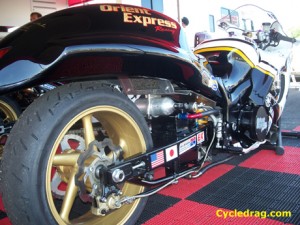
Perhaps Pro Street does have more of a true street bike look than Outlaw Pro Street. But that now raises the question, will MIROCK fans have a hard time differentiating Pro Street from the very similar Pro Sport Bike class? Even Miller agrees the two classes aren’t that much different, but feels the upside of two seemingly healthy classes makes it worthwhile.
“I do think Pro Sport Bike and Pro Street are very similar. Pro Sport Bike counts last year were really good so we decided not to touch that class,” Miller said. “We have a lot of Pro Sport Bike guys looking to step up to Pro Street.”
Miller also cites MIROCK’s change from Outlaw to Pro Street as an attempt to standardize the sport. Miller says MIROCK has been working together with fellow motorcycle drag racing league AMA Dragbike to try provide racers with similar rules.
“Back when we first became an organization we wanted to keep things separate from AMA Dragbike (then AMA Prostar). Looking back I don’t think that was the right move. It was time for a change. We’re in the business of making things better,” Miller said.
Miller hopes assimilating to other sanctioning bodies will make the sport easier to understand.
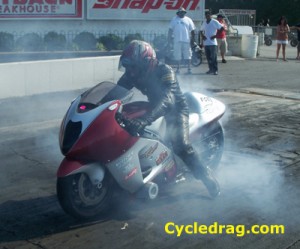
“To people outside of the motorcycle drag racing world all of our different classes can be very confusing. You look at the car world with classes like Outlaw 10.5, Pro Mod and Drag Radial – these categories are well known and have very similar rules at different racetracks and in different organizations. Car racing has been around a lot longer and is a lot more popular so it’s a good example to lead by,” Miller said. “If we can have 50 Pro Street bikes in the country as opposed to having 16 Outlaws and 16 Pro Streets, each race will have a chance at getting more entries.”
In another attempt to standardize the sport, MIROCK’s True Street was renamed Real Street to match AMA Dragbike.
One major difference from the MIROCK and AMA Dragbike Pro Street rules is that MIROCK is allowing the nitrous Outlaw bikes to compete in Pro Street, providing they make the necessary changes to their motorcycles – changes Miller estimates to cost most racers about $400.
“They have to put a street tire on the back, groove the front slick so it appears like a street tire, and put a headlight in the front of it and a taillight on the back. It won’t cost them anymore than $400 to convert the bike, including the price of the tires,” Miller said. “I definitely think they can be competitive but it’s going to take some work and time.”
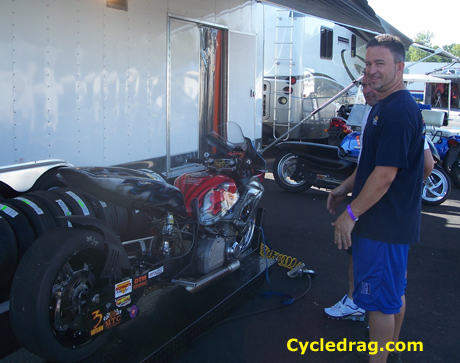
Hunnicutt disagrees with Miller’s cost estimate.
“It’s more than $400 because you have to buy a back rim. All the Outlaws run an 18-inch wheel and they will all have to go to a 17-inch rim to run a street tire. So right there you are spending at least $500 just for the back wheel,” Hunnicutt said. “Plus we would have worn out a lot of motors trying to learn to be competitive with the new rules.”
Hunnicutt does not plan to compete under the new set of rules and says it’s not the price to convert that turned him away, it’s the lack of long term commitment he received when he asked MIROCK officials how long Outlaws could expect to participate in Pro Street.
“I was told we could only be guaranteed a year under these rules and if we went faster than the turbos they would slow us down immediately. Why handicap us right off the bat?” Hunnicutt said. “That was the straw that broke the camels back. I would have to spend money to change my bike over for something that’s only going to last a year anyhow.”
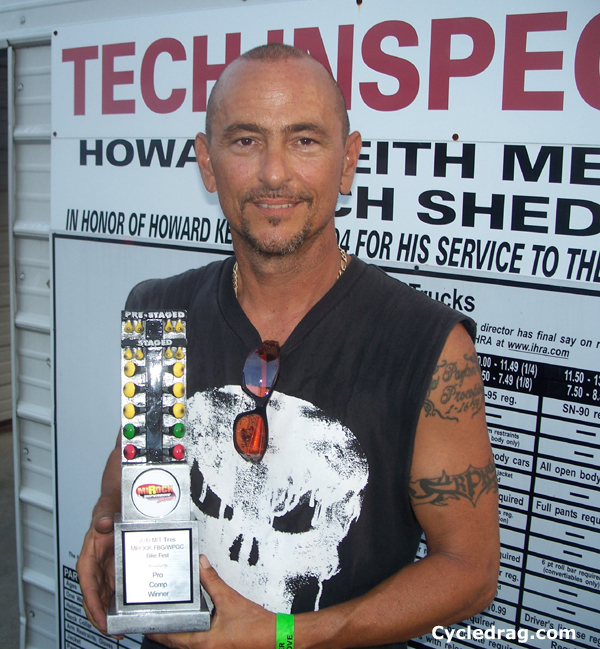
Procopio plans to sell his Outlaw Pro Street bike and echoed Hunnicutts sentiments.
“We’re only being grandfathered in for one year. So why would we waste all of this time and money to find out one year later we would have to change everything?” Procopio said. “I’d rather sell my bike and keep my motor as a spare for my Pro Mod.”
Several of the Outlaw racers have decided to sell their bikes, but as Hunnicutt points out, finding a buyer may not be easy.
“This has taken the value of my bike from $25,000 to between $10,000-$15,000 because there is nowhere to race them,” Hunnicutt said.
Hunnicutt thinks the affordability of an Outlaw Pro Street over a Pro Street is one of the reasons the Outlaw riders were only guaranteed a year in the class.
“Dan Wagner (DTM Performance) can build someone a bike for under $40,000 when a lot of the Pro Street turbo bikes cost $40,000 with you providing a bike, and that doesn’t include the engine consulting Dan offers,” Hunnicutt said.
Miller feels confident MIROCK made the best decision possible and believes the series will continue to grow with Pro Street as the headline class.
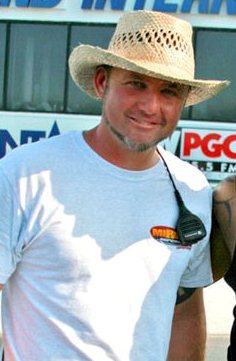
“Pro Street is one of the most popular classes out there and there are a lot of racers that had expressed interest in running Pro Street at MIROCK,” Miller said. “I think we are going to need everyone to come out and support the sport they love and the people that sponsor it. They are the ones that keep it going.”


